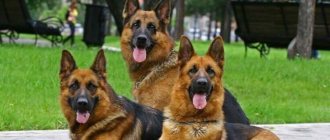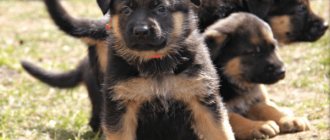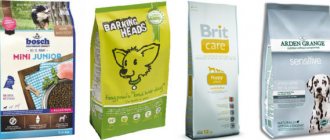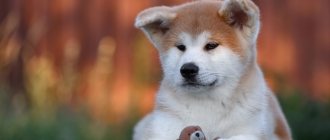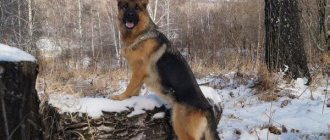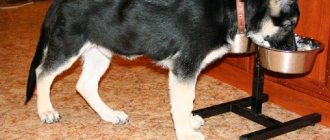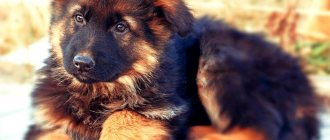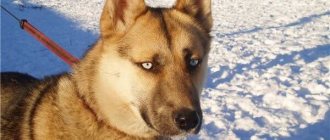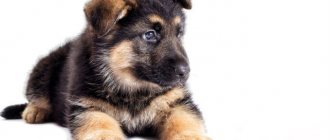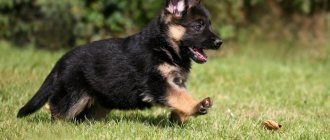German Shepherds are extremely intelligent and noble animals.
They are devoted to their owner and are ready to protect him to the very end, but without long-term care and nutrition, the pet cannot live a long and happy life.
Shepherd dogs have good health, but there are nuances in caring for them that must be taken into account when purchasing a puppy.
We will talk about these nuances in the article.
How to care for a puppy?
German Shepherd puppies are very active and temperamental, and if they are not cared for properly, they will not grow into good guard dogs. When purchasing a puppy of this breed, the owner must understand how much responsibility he takes on.
It is best to keep German Shepherds outdoors in a spacious enclosure in a private home. This applies to both adult dogs and small puppies. The pet will need to run and play a lot, and a large enclosure with a platform, a canopy and an insulated kennel where the puppy can wait out the bad weather is perfect for this.
You can keep the animal in an apartment, then you will have to arrange its own place in a warm corner, hidden from drafts. To do this, you will need to buy or make a soft bed with replaceable pillowcases, which must be changed twice a week for hygienic purposes.
At first, the puppy may be sad and miss its mother. To calm the animal a little, you need to pet it, give it some goodies, play, cuddle it, and calm it down with a gentle voice. German Shepherds are very intelligent and have a great sense of emotions.
Walk
If the puppy lives in an apartment, then you need to walk him a lot. 30 minutes is enough for a very small two-month old, but a six-month-old teenager can walk for up to 2-3 hours straight. If the puppy calms down and lies down right on the street, it means he has had a walk and can be taken home.
There are several factors to consider while walking:
- The puppy does not need additional loads; you should not force him to run after a bicycle or endlessly throw a stick at him;
- in the company of relatives, the puppy gets tired much faster, this is a good way to shorten the walking time and teach the pet to contact other animals;
- puppies love active games, they will happily run after a ball or a stick, but you should not harass the animal with such activity.
The older the animal gets, the less time it needs to walk.
Hygiene procedures
The most important thing when caring for a Shepherd puppy is to watch his eyes. If the eyes are red, watery, or pus is oozing from them, then you need to contact your veterinarian and follow all the recommendations prescribed by him.
Other hygiene procedures should be followed:
- brushing your teeth once every three months using a special toothpaste or powder. Special bones made of leather will help fix the teeth;
- cleaning the ears once a month using cotton swabs and a special product that is sold in veterinary pharmacies. If inflammation is detected, you must contact a veterinarian;
- bathing no more than 2-3 times a month only when absolutely necessary.
Caring for puppies is not at all difficult; it is important to maintain basic hygiene.
Nutrition
In the first weeks, to feed the puppy the same food that the breeder fed him to avoid severe stress in the baby. At six months of age, the puppy only needs 2-3 large meals on a specific schedule, the food bowl should be given at a certain time for 20 minutes and then removed.
NOTE!
Every week you need to check the growth chart and if there are strong deviations up or down, regulate this with the help of your diet.
The puppy can be fed both natural food and specialized food for puppies, but the most preferable option is a combination of natural and dry food.
Feeding your puppy regular food from the table strictly prohibited; this risks not only addiction and further begging, but also health problems, such as obesity.
The puppy should always have a bowl of clean, fresh water within easy reach.
Walks in the open air
Next, we will talk about the features of keeping and caring for animals of this breed. Full care for a shepherd is impossible without walking. When the puppy has received the necessary vaccinations, he needs to be walked regularly and for a long time. The first walks do not last more than 5 minutes. A two-month-old puppy is accustomed to a leash and walked for up to half an hour.
By 6–10 months, the duration of the walk increases to 2–3 hours. The pet needs communication with other purebred dogs, and it is better to protect it from strays. It is better to take your pet out during the day so that it receives beneficial ultraviolet light.
Basic rules for keeping an adult dog
Before accepting a new family member in the person of a German Shepherd, you need to familiarize yourself with the basic rules for its care:
- proper nutrition. The health and life expectancy of an animal depends on nutrition. The main principles: do not feed from the table, do not overfeed, give only the food that the dog can eat and that is appropriate for its age, there should always be fresh water available;
- health . It is necessary to take your pet for a preventive examination to the veterinarian once a year, but if there is a suspicion of a disease, then treatment should be started as soon as possible;
- physical activity . You need to provide your pet with sufficient space for physical activity (for example, an enclosure in a private house) or often take him for a walk. You need to play with your dog for at least one hour a day to release its physical activity;
- training and socialization . At a young age, a puppy needs to be introduced to other dogs and people, and picked up more often so that it gets used to people. In adolescence, you can already begin training, which German Shepherds respond very well to. You can train an animal throughout its life, rewarding it for success, as this not only disciplines, but also brings the pet and owner closer together.
Keeping a German Shepherd is not particularly difficult, but it still requires some attention and time.
Expert opinion
Kozhevin Semyon Kirillovich
Expert dog handler.
At first, when the puppy is still small, it is necessary to carefully monitor his health - if even a slight malaise is noticed, then you need to contact a veterinarian as soon as possible. Purebred animals are prone to diseases inherent to their breed, and if the problem is identified earlier, it will be easier to treat.
Proper nutrition is the second key to success. Without a properly formulated diet, a dog will not grow up happy and healthy.
Caring for a German Shepherd in terms of hygiene is quite simple - brushing the coat twice a week, cleaning the ears and teeth once a month (or when dirty) and bathing as necessary.
Vaccination
When keeping a German Shepherd, it is important to pay close attention to the vaccination of your pet.
Dogs are constantly outdoors, in contact with other animals and the environment. To avoid infectious diseases of your pet and parasitic infection, it is important to give him all timely vaccinations.
The first vaccination for a German Shepherd puppy is given at one month of age. After vaccination, the dog must be especially carefully cared for: check his temperature, do not overcool him. The next vaccine is administered after a month.
The puppy's last vaccination is given at the age of 4–7 months. After this, the baby is allowed to walk outside. Further, routine vaccination should be carried out annually.
Personal place
The best place for a dog in the house is a spacious enclosure, but if you decide to keep your pet in an apartment, then you need to arrange a comfortable place for him, which must meet certain parameters:
- The size of the bed should be large enough for the animal to lie on it comfortably. Pillowcases or mattresses should be removable so that they can be washed periodically;
- The bed should be located away from drafts so that the dog does not get sick;
- It is advisable to place the “bed” away from the passages so as not to disturb the dog while sleeping at home.
You can place the bed next to your own bed if such close proximity to your beloved pet does not bother you. The German Shepherd will carefully guard the owner's sleep.
Adaptation
Keeping a large, playful dog in an apartment is not an easy task. However, many problems can be avoided with a competent approach to raising a puppy. From the first days of the baby’s arrival in the house, the breeder needs to choose a convenient and comfortable place for him. The pet must remember its corner and rest there as needed. It should be bright and secluded. Sometimes a dog needs to be alone and gain strength after active games. An excellent solution would be to build an enclosure for a puppy. As your pet gets older, the “walls” can be removed.
A bed for a German Shepherd should be made of natural materials. A mattress whose pillowcases can be easily removed and washed is suitable. “Germans” love to study various subjects and try things out. Therefore, your pet will need a whole arsenal of toys and special bones. It is better to keep shoes away from the puppy. He will undoubtedly show a keen interest in her.
Males have an independent character and tend to dominate. With proper training, many problems can be avoided. Another weakness of the “Germans” is sexual desire. Males, sensing a female individual, can fall into an inadequate state and show aggression towards others. Girls have a soft and flexible disposition. They are easier to train and teach commands.
How to feed?
The German Shepherd is a fairly large dog that requires large amounts of food daily. Each owner chooses for himself how and what to feed his pet, but it is important to follow a number of rules to maintain the health of the pet.
Dry food
With dry food, everything is simple - it does not need to be prepared, it is stored for a long time and has the necessary set of substances for the development of a dog. You should not save on dry food and buy low-quality food - this will not end well, since the body of purebred dogs is more sensitive to low-quality food.
You need to feed your dog dry food at approximately the same time in limited portions, and fresh, clean water should always be available.
Natural food
With natural food, everything is more complicated - it needs to be prepared separately for the animal (it is strictly forbidden to give the same thing that the owner eats) and only from those products that are allowed for representatives of this breed.
The proper diet for an adult dog consists of:
- 30% meat . The dog gets the necessary protein from meat. You can give it raw, cut into small pieces or lightly boiled with boiling water. Chicken, lean pork, and beef are excellent. Meat can be mixed with porridge;
- offal . All of them are given raw, except for the liver, since there may be helminths there; it is first boiled;
- cereals _ Shepherd dogs can eat any porridge, including milk porridge, except for semolina, which is poorly excreted from the animal’s body;
- dairy . Cottage cheese, kefir and yogurt should occupy a significant place in the animal’s diet;
- vegetables and fruits . Shepherd dogs happily eat zucchini, pumpkin, beets, cabbage, and greens. You can give them cut into pieces or grated. Fruits - as a treat in small portions with the addition of a small amount of butter or sour cream for better absorption.
Feeding with natural food outperforms dry food in terms of variety, but loses in terms of time.
IMPORTANT!
Whatever the dog’s diet, the animal must have clean water around the clock. It needs to be changed daily.
German Shepherd's attitude towards children
Despite their rather impressive size and menacing appearance, German Shepherds are considered one of the best nannies for children of almost any age category. With proper upbringing and training, such pets have a stable psyche, are friendly and have a good disposition towards all household members.
The German Shepherd is very fond of children of different ages, and due to its well-developed natural intelligence, it understands perfectly well that it is necessary to treat them not only affectionately, but also with extreme caution. An adult German Shepherd is capable of caring for and protecting the owner's children, and also enjoys playing with them, so this breed is perfect for keeping at home.
Are vaccinations necessary?
Vaccination is a great way to avoid many diseases and further health problems for your animal.
They need to be done according to a specific schedule:
- The puppy is vaccinated against hepatitis, parvovirus and coronavirus enteritis at the age of 1.5 months, and two weeks later, as prescribed by the veterinarian, they are re-vaccinated;
- The puppy is vaccinated against canine distemper at three months, and again after 6 months;
- Vaccinated against leptospirosis at 4 months;
- At 6 months they are vaccinated against rabies and repeated every year.
The listed vaccinations must be done according to schedule, otherwise serious health problems cannot be avoided. There are also a number of vaccinations that owners do at will (vaccinations against microsporia, trichophytosis, parainfluenza).
Nutrition
The most important thing in caring for a German Shepherd is proper nutrition. It is the key to the health and longevity of your pet. To get started, you can create a feeding schedule.
A two-month-old puppy needs to be fed 5 times a day, and then reduce the number of feedings as he gets older. At three months - 4 times a day, at three to six months - 3 times, and from seven months on, switch to two meals a day. You must include protein-rich foods in your diet. It is important that during cooking the food loses as few vitamins as possible, and that the food itself is tasty and easily absorbed by the body. When feeding a German Shepherd, it is recommended to use boiled rather than raw foods.
And the dog should be fed from unbreakable dishes - enamel or aluminum; when buying a bowl, make sure that its bottom is perfectly smooth, so that when licking the food, the dog does not injure its tongue. When serving food to a shepherd dog, it must be warm, not cold or hot.
The dog should be given clean boiled or raw water at room temperature. How much water a shepherd dog consumes per day depends on its age, body weight and, of course, nutrition. For a puppy, the amount of water is calculated to be 100 ml per 1 kilogram of weight, and for an adult dog - 50 ml. Do not allow your lice dog to drink from ponds or puddles, as germs may be present there. And if you are going on a hike, then you need to take a supply of water with you for yourself and your four-legged friend.
Grooming
Wool is one of the indicators of good animal health. If it is faded, dull and falls out, then you should take your pet to the veterinarian for an examination.
Hygienic grooming should begin as soon as the puppy arrives in the family, so that it gets used to the procedures. This is not the most pleasant process for dogs, so you will have to be patient.
There are two types of shepherd dogs:
- long-haired;
- shorthaired
To care for fur, you need to purchase the following equipment from a pet store:
- massage comb with metal teeth (long for long-haired dogs, medium for short-haired dogs);
- a slicker comb for brushing a dog during shedding;
- metal comb for combing hair;
- specialized shampoo and conditioner for animals.
Twice a year the dog begins to actively shed, during this period you need to comb the animal with a slicker comb, during the rest of the period 1-2 times a week you need to go through the fur with a massage brush to avoid the formation of tangles.
You only need to trim the hair in the neck and hind legs for the dog’s comfort. Only long-haired Shepherds require a haircut.
Feeding with natural food
Main points:
- It is preferable to feed an adult German Shepherd with natural food, especially if it lives on the street and, especially, in the cold season. Food should be warm (not hot).
- The serving size and number of feedings varies depending on the time of year and appetite. In the warm season, a German shepherd eats 2-2.5 liters of porridge with meat and vegetables per day for 2 feedings, that is, 1 liter in the morning and in the evening.
- If your appetite is poor, you can feed them 2 times a day, 1 time a day. Do not leave the bowl for more than 20 minutes, especially in summer.
- In cold weather, you can either increase the amount of food to 1.5 liters per meal (with two meals a day), or continue to feed 1 liter, but three times a day.
- Remove the bowl immediately after feeding to prevent the dog from gnawing on it.
- Food should be high-calorie and varied. Cook as for yourself. Salt - to taste, you can add a little salt. Do not feed porridge from a mixture of the same cereals day after day. And in general, do not make mixtures. It’s better to cook rice today, buckwheat tomorrow, wheat the day after tomorrow, etc. Better yet, give him rice porridge in the morning and wheat porridge in the evening. The dog also gets tired of the monotony, and each grain has a different cooking time.
Porridge
What grains can I use? Any except pearl barley and barley. They are poorly digested and cause loose stools. Rice, buckwheat, wheat, millet, corn, and oatmeal are suitable.
- Do not feed too thick porridge.
- Cook the porridge with meat and vegetables. It, of course, has a shorter shelf life than thick, boiled in water, but it is much tastier for the dog and healthier.
Vegetables
The set of vegetables should also vary: if yesterday and today you cooked porridge with cabbage and beets, then tomorrow cook it with zucchini or carrots.
You can use almost any vegetables: cabbage, carrots, beets, onions and green onions, pumpkin, zucchini, sweet peppers, cucumbers. Just cut them into small cubes or grate them on a coarse grater. Boiled vegetables are better absorbed than raw ones.
Meat
The daily diet should contain at least 600 grams of meat or meat products. No bones! An adult dog generally does not need bones more than once or twice a week to clean his teeth and satisfy the need to chew.
What kind of meat should I give? Beef, lamb, horse meat, poultry (boneless). It is not necessary (although it is desirable!) pulp. You can use meat trimmings from the head, beef tails, liver, lung, kidneys, stomach, ears cleaned of wool (as an addition), chicken necks, heads of broiler chickens (remove the beak and side sharp bones), backs of broiler chickens.
Absolutely do not give chicken feet! You can cook broth for your dog on them, but the paws themselves are in the trash! Yes, don’t feed liver and lungs for more than two days, as they weaken you.
Cut the meat into pieces and mix with porridge and vegetables so that the dog eats everything in a row and does not choose the meat, leaving the porridge uneaten.
Various tips
- Teach your dog to a raw diet of vegetables, fruits and berries. This will be much better than industrial chemical vitamins. At first, you can give your dog an apple, pear or beetroot instead of a ball, or a carrot or cabbage stalk as a toy. Gradually, the dog will learn not only to play with them, but also to eat. Many dogs are very fond of apples, pears, watermelons, melons, apricots (pitted), bananas, tomatoes, cucumbers, etc. The main thing is to teach them in time.
- If possible, you can give boiled boneless fish instead of meat 1-2 times a week.
- Your dog won’t refuse cottage cheese and kefir a couple of times a week (as a supplement to the main diet).
- If the dog does not eat vegetables, fruits and berries, then special vitamins and minerals need to be introduced into the diet from time to time. Pet stores have a fairly wide selection.
Author of articles Oksana Gromova Practicing dog handler for German shepherds. 30 years of experience.
Once again I would like to remind you that meat should under no circumstances be replaced with dry food: throw a couple of grains of food into the porridge cooked in water and - voila! No! No! And - no! Feed is cereal with a certain % of meat products (often by-products!). That is, in this version you give porridge with porridge and a meager amount of protein. This is NOT the way to feed!
- If your dog requires vitamins and minerals, buy ready-made good vitamins. Balanced! Don't reinvent the wheel by grinding eggshells, burning bones into bone meal, etc. You will not make this a full-fledged feeding.
- Try not to feed your dog too late. Do not eat before training, especially before defense classes, jogging, or preparing for exhibitions, if you do not want to get bloat. It will be impossible to save. The optimal time for morning feeding is 5-9 hours, for evening feeding – 17-19 hours.
How to properly maintain an apartment?
If it has been decided to keep a German Shepherd in an apartment, then you need to arrange a cozy place for it in the living room (you cannot place the dog in the bathroom, kitchen, hallway or balcony) away from drafts and heat sources.
NOTE!
Shepherds shed a lot, so it is important to regularly clean the apartment, especially if children, pensioners, or allergy sufferers live there.
What accessories and toys are needed?
Before you bring your dog into your home, you need to purchase all the accessories necessary for it, such as:
- bowls for food and water (ceramic ones are preferable, they are more stable, preferably on a stand so that the pet does not have to bend over too much);
- a bed of a suitable size;
- everyday comb, slicker brush;
- hair shampoo, conditioner;
- hygiene products (for washing eyes, cleaning ears, etc.);
- collar and leash (for shepherd dogs you need strong, thick ones, made of durable material, but not a chain);
- toys.
Shepherds, especially at a young age, love to play, and toys will only please them. These can be rubber bones, balls, sticks, ropes and any other toys. The owner should be prepared for the fact that he will have to buy new toys often, since shepherd dogs have fairly strong jaws and strong teeth.
Walking rules
If the shepherd lives in an apartment, then you need to walk with it at least 1.5-2 hours a day. You need to walk your pet in a spacious, open area, where he can run around to his heart's content, frolic, and play with a stick.
Ideal options would be:
- forest or forest belt;
- field;
- wasteland;
- big park.
If there are a lot of people around, especially children, then you need to walk the dog on a leash, even if it is very well-mannered. During play, a massive dog may not notice the child and knock him down, which in the future can cause problems for the owner of the animal.
As for walking in winter, in most cases shepherds do not need clothing - these dogs feel quite well at temperatures down to -10 degrees. But if the weather is too cold, then you can buy a jumpsuit for your pet.
How to trim nails and clean ears correctly?
From infancy, you need to accustom your dog to having its teeth brushed periodically. If you do everything correctly, then in adulthood the pet will tolerate this procedure calmly.
For cleaning you need to purchase:
- a special brush for dogs;
- special toothpaste.
You need to brush your teeth once a month and at a time when the dog is calm. The best time is after an active walk, when the animal is tired and does not resist. You need to brush your teeth once every 1-2 months.
Trimming the nails of an inexperienced dog breeder can cause a lot of trouble, since shepherd dogs' nails are black and not translucent; it is not visible where the void ends and the living tissue begins. The best option is to take your dog to a professional for nail trimming.
The right diet
An important element of proper care and maintenance is a balanced diet. There are two options for feeding a German Shepherd:
- Natural food.
- Ready-made feed.
A natural diet includes meat, grains, vegetables and fruits. For animal protein, preference should be given to veal, chicken and turkey. Pork should not be given. Porridge should make up no more than 30% of the diet. Add a tablespoon of vegetable oil to them.
Fish, cleaned of bones, is given when the shepherd dog is one year old. The puppy’s diet contains fermented milk products: cottage cheese and kefir. Once a week you can add the yolk of one chicken egg to your food. Finely chop or grate vegetables and fruits. Bread, sweets, and spices should not be given.
German Shepherd puppies have very long hind legs. Therefore, it is recommended to add fertilizer containing calcium and phosphorus to the natural diet. This way you can avoid joint problems and rickets.
With the second feeding option, preference should be given to premium food. They are rich in all the vitamins and minerals a German Shepherd needs. Food should be selected according to the age and size of the German breed dog.
How to bathe?
You need to bathe your shepherd dog as it becomes dirty, preferably no more than 1-2 times a month, otherwise the shampoo will wash away the protective substances from its fur, which can lead to diseases. If the dog gets slightly dirty after a walk, it can be rinsed with warm water; it is not necessary to use detergents.
It is best to bathe in the bathroom using a shower. First, you need to wet the coat, then apply shampoo, lather and rinse thoroughly, and then treat the dog with conditioner.
CAREFULLY!
If you do not completely rinse the detergents from the animal's fur, severe irritation may appear on its skin.
How to train?
The German Shepherd is highly trainable, but it is important to start teaching it commands from infancy. If you miss this period, then in the future the dog will perceive the owner’s commands much worse.
In no case should you hit or severely punish a dog for failures, but you can and even need to punish for disobedience. If the puppy resists something and misbehaves, then you need to lightly press him by the scruff of the neck to the floor and sternly say “Ugh!” So, without violence, the pet will very quickly understand what this signal means and will obey it.
The German Shepherd is an ideal guard and good friend, loyal, loving and very brave. Representatives of this breed are ready to protect their owner and their family members until their last breath. They are very smart and quick-witted and that is why they can easily become full-fledged members of the family.
Upbringing
It is important to immediately provide the dog with a permanent place to rest. A puppy should be trained by the person he listens to without fear.
In order to correctly build a training methodology, it is necessary to study the individual characteristics of the pet and understand which approach is right for him. You cannot physically punish a puppy; an unwanted action must be accompanied by the creation of conditions that will create negative emotions in him
A puppy should be trained by the person he listens to without fear. In order to correctly build a training methodology, it is necessary to study the individual characteristics of the pet and understand which approach is right for him. You cannot physically punish a puppy; an unwanted action must be accompanied by the creation of conditions that will create negative emotions in him.
Commands are given in an even voice, but with an orderly intonation. You cannot leave any exercise undone, otherwise the dog will obey the owner at will. All correctly performed actions of the puppy are reinforced with treats, praise and play.
